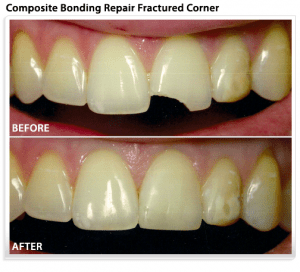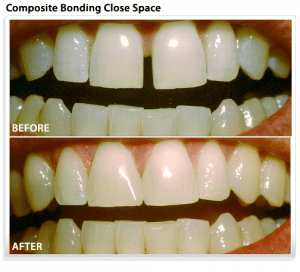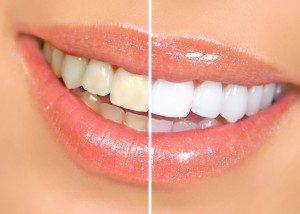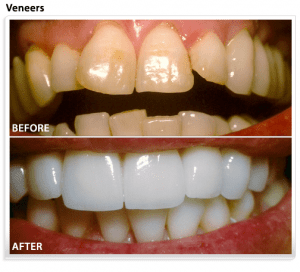
In every dental procedure, cosmetic dentistry is involved. All procedures whether cleaning teeth, rebuilding, restoring, or replacing teeth are cosmetic in nature. Each tooth, each case becomes individual in nature and so all the possibilities should be explored.
Cosmetic dentistry is anything that will improve or maintain the appearance of the patient’s teeth. This can be something as simple as re-shaping a tooth and bleaching a tooth, which can improve the appearance dramatically by being very, very simple, or, if need be, you can get very aggressive with cosmetic dentistry.
Thankfully in today’s dental world, there are materials that are simply outstanding allowing the dentists at Ventura Total Dentistry to get life-like results for our patients. Porcelain veneers, for example, will simply cover the outer surface of the tooth with a very thin layer of porcelain, approximately half a millimeter and create a beautiful result.
Conservative Cosmetic Dentistry Can Go A Long Way
Cosmetic dentistry can range anywhere from doing the very, very simple, such as re-shaping a tooth, to the very aggressive where you crown a tooth, and everything in between. For instance, instead of crowning a tooth to close spaces between a patient’s teeth, we may be able to do this job very conservatively, if the overall shape of the tooth is nice, by simply bonding some composite material to the tooth and changing the shape subtly. This doesn’t seem like much, but in the long run, this type of procedure can have a very dramatic effect on the patient’s smile.
This is a situation where you’ve got to be very, very aware of what you’re trying to accomplish, and the techniques and also, your artistic ability at this point, and this is where your dentist can get a little creative, in terms of colors, shapes and contours.
Cosmetic dentistry does not always mean a mouth full of veneers. It could be something as simple as re-shaping and bleaching teeth, and in some cases, it could be as simple as cleaning a patient’s teeth and getting into spots where they haven’t been able to get to in a long time and have accumulated stains and deposits on their teeth. Cleaning out these trouble areas could provide a great cosmetic result for the patient.
If you do something conservatively, you can always take more away. But, if you do it aggressively, you can never put it back.
Every once in a while, more aggressive dental procedures may not be avoidable simply because the situation calls for it. A good example of a situation like this may be, for instance, if there happens to be a fractured tooth and that tooth needs to get some support in order to prolong its life. This is one of those times where you must get more aggressive with the situation.
Cosmetic Bonding
 Dentists have been cosmetically bonding resin material to teeth since the early 1970’s when the first composite resins became available. Since then, both composite resins and bonding materials that allow the resins to “stick” to a tooth, have improved dramatically.
Dentists have been cosmetically bonding resin material to teeth since the early 1970’s when the first composite resins became available. Since then, both composite resins and bonding materials that allow the resins to “stick” to a tooth, have improved dramatically.
Today, dentists are able to add material to teeth in such a manner that the cosmetic bonding appears to be a natural part of the tooth. These materials can be used where teeth have decayed, fractured, worn, or simply developed to a less than ideal shape. Cosmetic bonding can be done to close spaces, reshape teeth, or replace older dark fillings.

Bonding does have some shortcomings though, which are generally related to the size or position of the restoration. Very large restorations, or teeth in areas where there is a large amount of wear, may be better suited for restorations produced in a laboratory such as a crown or veneer. However, each case and tooth must be evaluated individually in order to produce the most desired result.
Porcelain Veneers
Porcelain veneers are the ultimate esthetic restoration. They have the ability to totally restore the appearance of a tooth and yet, only cover a portion of that tooth. A porcelain veneer is a thin piece of porcelain that is fabricated in a laboratory and then bonded to the front surface of the tooth.
In most cases, a minimal amount of tooth structure must be removed to make space to place the veneer. Occasionally, very minimal or no reduction is necessary because the tooth, or teeth, have worn or were undersized naturally.
Veneers can be used to reshape an individual tooth or an entire arch of teeth. They can be used to close spaces, lengthen teeth, mask stains, or change colors. The very first veneers were fabricated to mask darkly stained teeth (generally from antibiotics taken when the teeth were still forming) and tended to be very opaque in appearance. With much better materials and bonding agents, today they can appear very natural.
Cosmetic Reshaping
The easiest procedure that can achieve remarkable results is to simply cosmetically reshape teeth that may not appear “nice.” This dental procedure is appropriate when there has been chipping, wear or even, shifting of teeth.
Many dental patients believe that the only way to change their smile is to add material to the teeth, but there are many cases where the very simple procedure of cosmetically reshaping teeth, can greatly improve the overall smile. There is no need for any anesthesia and generally, a preview can be shown in the mouth before anything is altered.
Teeth Whitening
 Teeth whitening, or bleaching of the teeth, is a very conservative procedure that can produce great results for minimal cost and no invasive treatment. Teeth whitening is best done at home after custom fitted trays are made for the patient.
This simple procedure requires having two impressions taken in the dental office. The patient will wear these trays with a bleach solution for approximately 7-14 days for 2-3 hours per day.The results are long lasting but may require 1 or 2 nights of touch-up every 6 months.
The only possible side effect is a temporary sensitivity. Dental bleach materials today all contain products, such as fluoride, to reduce this sensitivity. Bleaching is best suited for teeth that have become darker with aging, but can be used successfully by patients of all ages.
Teeth whitening, or bleaching of the teeth, is a very conservative procedure that can produce great results for minimal cost and no invasive treatment. Teeth whitening is best done at home after custom fitted trays are made for the patient.
This simple procedure requires having two impressions taken in the dental office. The patient will wear these trays with a bleach solution for approximately 7-14 days for 2-3 hours per day.The results are long lasting but may require 1 or 2 nights of touch-up every 6 months.
The only possible side effect is a temporary sensitivity. Dental bleach materials today all contain products, such as fluoride, to reduce this sensitivity. Bleaching is best suited for teeth that have become darker with aging, but can be used successfully by patients of all ages.

